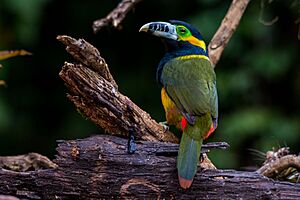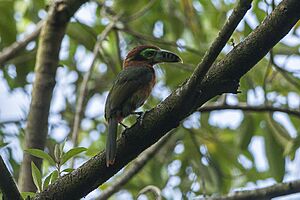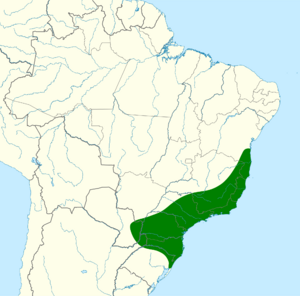Spot-billed toucanet facts for kids
Quick facts for kids Spot-billed toucanet |
|
|---|---|
 |
|
| Male in Brazil | |
 |
|
| Female in Brazil | |
| Conservation status | |
| Scientific classification | |
| Genus: |
Selenidera
|
| Species: |
maculirostris
|
 |
|
| Synonyms | |
|
|
The spot-billed toucanet is a colorful bird from the toucan family, called Ramphastidae. You can find it living in parts of Argentina, Brazil, and Paraguay. Its scientific name is Selenidera maculirostris. It's a type of bird known as a near-passerine, which means it's not a true songbird but has some similar features.
Contents
About the Spot-billed Toucanet's Family Tree
The spot-billed toucanet was first described as part of a different bird group, Pteroglossus. Scientists later realized it was closely related to Gould's toucanet (S. gouldii). These two toucanets are like "sister species," meaning they share a very close ancestor. The spot-billed toucanet is considered monotypic, which means it's the only species in its specific group and doesn't have different subspecies.
What Does a Spot-billed Toucanet Look Like?
The spot-billed toucanet is about 33 to 37 centimeters (13 to 15 inches) long. It weighs between 137 and 193 grams (about 4.8 to 6.8 ounces).
How to Tell Males and Females Apart
Both male and female toucanets have the same pattern on their bills. However, the female's bill is a bit shorter. The bill has a thin black line at its base. The rest of the bill is mostly ivory (a creamy white color) near the base. It then turns greenish-yellow towards the tip.
The top part of the bill, called the culmen, has a black middle section. The upper jaw (the maxilla) has three to five black stripes going up and down. The lower jaw (the mandible) has a black patch near its end.
Around their eyes, both sexes have bare skin that is green-yellow to blue. Behind their eyes, they have a tuft of golden-yellow feathers. These colors are usually lighter in females.
Colors of Male and Female Toucanets
Adult male spot-billed toucanets have a black head, neck, chin, throat, and belly. Their upper body is green. They also have a yellow band on the lower part of their neck. Their tail is green, and the tips of the middle three pairs of tail feathers are chestnut (reddish-brown). Their sides are yellow, and the feathers under their tail (called coverts) are red.
Females have chestnut to cinnamon-rufous colors in the places where the male is black.
Young Toucanets
Young toucanets, called immatures, are generally duller in color. They usually don't have the yellow band on their back. The patterns on their bills are also not as clear or sharp as in adults.
Where Do Spot-billed Toucanets Live?
The spot-billed toucanet lives in Brazil, from the states of Bahia and Minas Gerais in the north, stretching south into eastern Paraguay. You can also find them in Argentina's Misiones Province.
Their Home: The Atlantic Forest
These birds are found in the Atlantic Forest, a special type of forest. They live in:
- old-growth forests (forests that haven't been disturbed much)
- secondary forest (forests that have grown back after being cut down)
- Forests where some trees have been cut (selectively logged)
- Small remaining patches of forest
- Palm groves
- gallery forests, which are forests along rivers at the edges of the cerrado (a type of savanna).
They can live from sea level up to at least 1,000 meters (about 3,300 feet) high.
How Spot-billed Toucanets Live Their Lives
Movement and Home Range
As far as we know, the spot-billed toucanet stays in the same area all year round. It doesn't migrate to different places.
What Do They Eat?
Spot-billed toucanets look for food from the ground level up to the middle layers of the forest. They usually search alone, in pairs, or in small groups.
Their diet includes:
- Fruits, such as those from Euterpe and Cecropia trees. In captivity, they also eat many cultivated fruits.
- Sometimes, they eat small animals. For example, in captivity, they have been known to eat dead young mice or baby birds (nestlings).
Scientists are still learning more about their exact diet in the wild.
Reproduction and Life Cycle
The breeding season for the spot-billed toucanet varies by location. In the northern parts of its range, it's from December to June. In the southern parts, it's from October to January.
In the wild, these birds build their nests inside holes in trees. Both the male and female parents help feed their young. Not much else is known about how they raise their families in nature.
When kept in captivity, female toucanets usually lay two or three eggs. The eggs hatch after about 15 days. The young birds are ready to leave the nest when they are about six to seven weeks old.
Sounds They Make
The spot-billed toucanet makes rough, growling sounds. These can be described as "ggrooaw" or "kkrowk" notes, often made in a series. Usually, the male and female will sing one at a time.
They also make other sounds, like:
- Low "tut" notes
- Rattling sounds
- Low purring notes
- Sounds made by snapping their bills together
Conservation Status: Are They Safe?
The IUCN (International Union for Conservation of Nature) has evaluated the spot-billed toucanet. They have listed it as a species of "Least Concern." This means that, for now, it's not considered to be in immediate danger of disappearing.
Even though it has a large area where it lives, the total number of these birds is not known. However, it's believed that their population might be slowly decreasing. No major threats have been identified right now.
The spot-billed toucanet is common in some protected areas. But in other places, it might be locally threatened due to human activities. More information is needed about how these birds breed in the wild to help protect them better.


